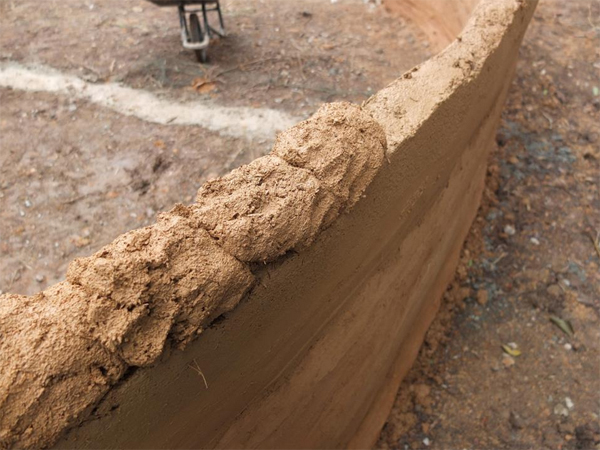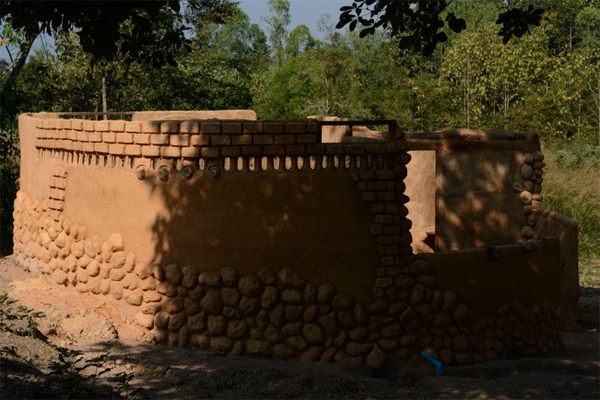
We reported on their adobe retreat center yesterday. Now New Life Foundation is building puddled adobe housing at their center in Chiang Rai, Thailand. This type of construction receives very little attention even though it’s one of the simplest, lowest cost building methods and has been around thousands of years. It’s believed the oldest house in the US — pre-Spanish — was built with puddled adobe. Among other things, puddled adobe would make good interior walls with adequate framing at doors.

“The meditation hall completed, our earthen building project continues with the first of many sustainable, environmentally friendly mud huts that we will build at New Life Foundation. The huts will be for long-term residents, staff, and volunteers, as well solitary meditation retreats.”


No conocia esta tecnica de construccion en barro en adobe encharcado, sería posible colocar dos tablas a manera de formaletas y rellenarla usando el barro mojado. Gracias por el comparta un abrazo, cuidense, saludo.
I did not know this mud construction technique in puddled adobe, it would be possible to place two boards as forms and fill it using the wet mud. Thank you for sharing a hug, take care, greetings.
According to Quentin Wilson, director of Northern New Mexico College’s Adobe Construction Program, “Adobe stands forever if it has a good foundation, a good roof and occupants who give it a bit of periodic maintenance.”
Owen is so right.
It is very easy for techniques get written off by many people.
Reality is that different techniques and different materials have different strengths and weaknesses. The trick is to choose the materials that take maximum advantage of your environment, while minimizing environmental impact. At the same time it’s best to choose techniques that take maximum advantage the skills of the people building, while minimizing their weaknesses.
No two sites are the same. No two people are the same. What’s ideal for me, may not be ideal for you. That’s not only acceptable, it’s expected.
There also are situations where someone may want to stretch their own knowledge and skill. Try something they have never tried before. That’s great too.
Give people permission to try things and make mistakes. You just might be surprised at what they are able to accomplish.
Who cares if two people agree or disagree? If both have built their own home and are happy with their own efforts, who is anyone to judge? The only opinion that really counts is the opinion of the person living in the house.
Lastly, honest disagreement can be a good thing. It is an opportunity for learning and growth.
For what it’s worth. If someone puddles their way to a home that they built themselves, I offer congratulations. I may not choose that technique, but I sure won’t find fault with their choice of techniques.
We always recommend trying out new ideas on small outbuildings like tool sheds. This is a low risk, easy to way to experiment with different building methods. Even if it doesn’t turn out perfect or quite like you hoped, you’ll still end up with a usable shed for very little money.
I find it ironic that in some cultures (such as ours) we strive to get new and improved only to find ourselves coming full circle, finding that less is best and less is more. Good post.
Interesting isn’t it? Many people are quick to write off these ancient building methods as “too labor intensive” without thinking about it carefully. These same people often go in debt and work mind numbing jobs for 30 years to pay for their home made of plastics, toxic glues, fiber board, asphalt and a bunch of other crap that slowly kills them. I think most people have been duped. So yes, we’ve come full circle and increasing numbers of people are waking out of their stupor.
Here’s an old photo showing another variation of puddled adobe. The man in the photo is hand shaping the adobe into fairly large adobe blocks on the wall. Yes, it’s a very slow process, but on the upside it eliminates forming adobes on the ground, rotating the blocks, moving and stacking them to dry and then moving and stacking on the wall in mortar.
Man building puddled adobe wall, Cochiti Pueblo, New Mexico http://econtent.unm.edu/cdm/ref/collection/acpa/id/11039
(very slow download for me)
It’s nice to see some of the oldest methods still being used.
Yes, I was glad to see this project. Do a search for puddled adobe and you’ll often get a stock answer about puddled adobe is labor intensive and was replaced by adobe. That’s only part of the story. I believe things are more nuanced (as usual). Hopefully this blog post adds a little balance. Tomorrow’s blog post will feature another puddled adobe project.
Here’s a little more info since there’s almost nothing available out there. The mix is similar to cob, but seems wetter and with less straw. The wet mix enables rapid shaping on the wall, but also requires more drying time before adding extra courses. This makes it best suited to hot, dry climates. You’ll see a lot of houses made this way in the Middle East and probably India and Africa.
Puddled adobe has fallen out of use in the West partly due to the fact the Spanish brought adobe block construction to the Americas and basically took control of so many things.
Puddled adobe is well suited to small projects such as outbuildings and interior walls. For houses, I recommend thicker walls for added strength. Thick walls of puddled adobe are more laborious than adobe blocks and earthbag.